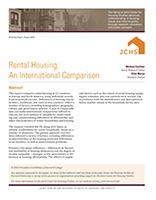Rental Housing: An International Comparison
This working paper compares rental housing in 12 countries in Europe and North America, using individual records from household surveys. Differences in housing characteristics, conditions, and costs across countries reflect a number of factors, including demographics, geography, culture, and government policies. A lack of comparable data can make international comparisons difficult to execute, but such analysis is valuable for understanding and contextualizing differences in affordability and other characteristics of renter households and housing.
The analysis revealed the US, along with Spain, as notably unaffordable for renter households, based on a number of measures. The greater apparent cost burdens reflected a variety of factors, including differences in characteristics of the housing stock and differences in tax burdens, as well as measurement problems.
However, two major influences – differences in the size and availability of housing allowances and the degree of income inequality – emerged as the main drivers of differences in housing affordability. The effects of supply-side factors such as the extent of social housing supply, supply subsidies, and rent controls were unclear, due to problems with the identification and description of below-market rentals in the household survey data.
Also available as a Research Brief.

